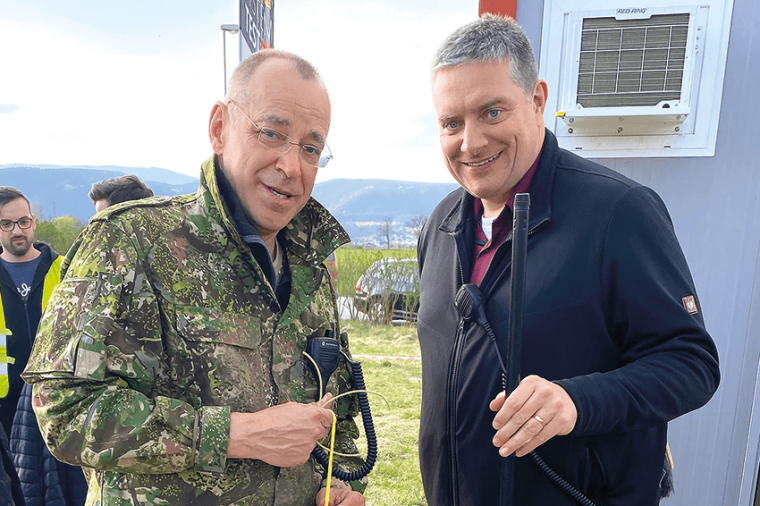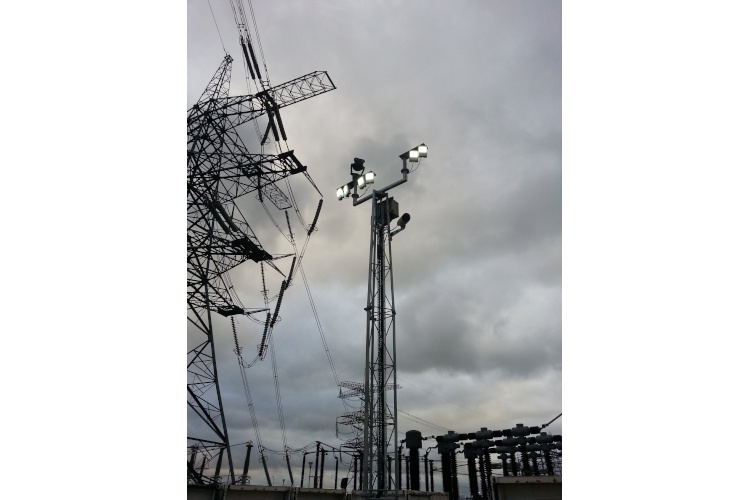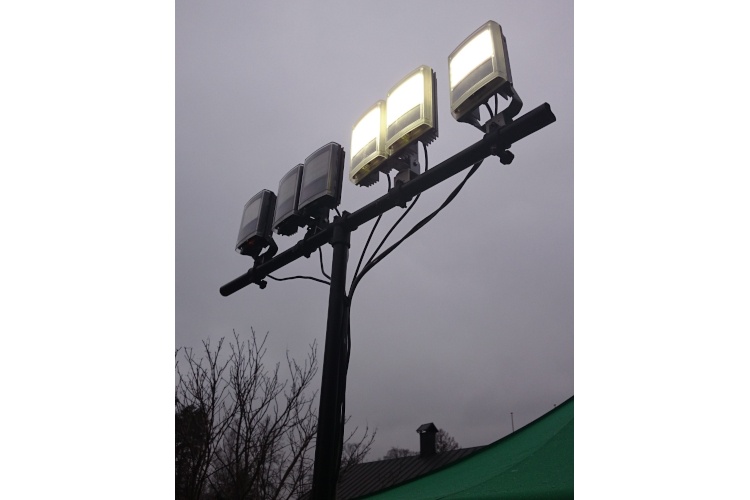Why Sufficient Light at the Perimeter is Really Important
During the GIT System Test Video Analytics, GIT SECURITY spoke with the two experts Markus Piendl and Eng. Hannes Dopler, MSc. on the subject of lighting and why good lighting can make or break perimeter protection projects.

How important is the matter of lighting at the perimeter? Why did our experts Markus Piendl and Hannes Dopler prefer combined infrared/white light illumination from Raytec for our GIT System Tests (the next tests are scheduled for April 2023)? And what traps can you fall into with the various lighting configurations? The answers and advice are, in the true sense of the word, illuminating.
GIT SECURITY: Hannes Dopler, what importance does lighting have in a perimeter protection concept?
Hannes Dopler: The lighting is an essential factor for the success of the security plan. Intruders are usually dressed in dark clothes and avoid any bright, well-lit or open spaces. Using white light can provide additional security by preventing any critical, neuralgic areas such as dark approach routes or terrain and avoiding any natural cover. It is important that permanent lighting is only installed where, on the one hand, it is considered necessary for personal security and, on the other hand, as a result of a security evaluation – one can consider approach roads, parking lots, loading bays, gates and doors, technical equipment installations. At other locations, the lighting can be controlled by motion detectors or other sensors. In these cases, adjacent areas should also be activated. Lighting equipment must not have any negative effects on the image quality of the video surveillance. The lighting should be able to be fully activated by the nighttime security personnel. Equally important is sabotage-resistant installation while still being accessible for maintenance, and a sustained power supply.
That sounds almost like a lighting plan that would be discussed with the clients of security system installation companies?
Hannes Dopler: Correct. Tactical considerations and also safety at work aspects could be the start times of lighting – think: summertime or wintertime – as well as the lighting intensity and direction. An example from real life: a fork lift driver was dazzled by the light from the warehouse opposite and did not see a person walking across the driveway.
But there are also natural sources of dazzling light – what can be done here?
Hannes Dopler: Think about the rising and setting sun. Cameras must not be blinded by the lighting and need the ideal lighting level. Look out for polished and bright surfaces, such as shopfront elements, glazed surfaces, decorative elements, air conditioning pipes, isolation of pipes and the reflections they create. Wet surfaces, paints and, outside, passing vehicles, in particular can all disrupt video analysis because of reflections.
How can an end-user or an installer get close to the ideal type of lighting?
Hannes Dopler: It must be established whether a narrow strip or a larger area is to be illuminated, or maybe just a spot. Generally an even, pleasant lighting is recommended. The video images should be checked at regular intervals both by day and by night. This is the only way to recognize faults, interference and alterations to the environment. It is also necessary to regularly trim greenery near the perimeter.
Markus Piendl, you point out possible mistakes when lighting perimeter areas in your presentations. Why is it then such a challenge for end customers and also for installers to develop a good lighting plan?
Markus Piendl: There were no recognized lighting standards in the security industry for a long time. In particular with regard to range, there were only the subjective details provided by the manufacturers themselves, who all claimed to have produced the best ever lamp. There were no reference images and even a testing ground was only rarely available.
What could be done?
Markus Piendl: These matters are usually discussed right at the start during successful projects with professional lighting: How far does the lamp reach, what form does its beam have, what angle has to be covered, how efficient and reliable is the lamp, what functionality does the lamp have, in particular when software integrated to prestigious video suppliers, how versatile is the lamp, how much power does the lamp consume, what lifetime can be expected, and how quickly can the manufacturer help with guarantee claims, certification or technical support?
Going back to the current GIT System Test Video Analytics: why did you decide to specifically use the hardware from Raytec?
Markus Piendl: In this case, the ‘POWERS’ standard developed by Raytec impressed us, the one created by Tony Whiting and David Lambert...
... both members of the Raytec management ...
Markus Piendl: ...right. And with POWERS it is possible to compare the lighting power as well as to include various influencing factors so that it is easy to compare and specify various lamps. It was important for us to establish clear and even illumination. The best image quality at night was only just about good enough to ensure that the video analysis could be optimally employed by minimizing the image noise. We are very happy that this worked, and that the feedback from the various manufacturers was entirely positive.
Hannes Dopler spoke extensively about white light and its advantages. We think we may have found in you a fan of infra-red light. Is that impression justified?
Markus Piendl: I like the discreet, hidden use of infra-red light over long distances. I do not consider it a disadvantage that the result is only a monochrome image, insofar as it is correctly interpreted by the security personnel. White light is an obvious deterrent, of course, but it also frequently assists criminals. Wherever the project and protected object allow, I have tended to use infra-red to grant the attending police the element of surprise and enable arrests. Hybrid solutions also exist, combining both infra-red 850nm and white light in a single lamp. These lamps provide great flexibility and could be a good option if you are lighting a perimeter which requires covert surveillance, but also want to use white light as a deterrent.




9-Point Check List for Professional Lighting
- How far does the lamp shine?
- What shape does its beam have?
- What angle of lighting must be covered?
- How efficient and reliable is the lamp?
- What functionality does the lamp have, in particular when software integrated to prestigious video suppliers?
- How versatile is the lamp?
- How much power does the lamp consume?
- What lifetime can be expected?
- How quickly can the manufacturer help with guarantee claims, certification or technical support?
‘POWERS’ at a Glance
There were no recognized standards in the security industry for the measurement of lighting distance for a long time. The only data on lamp range was the subjective publication of individual manufacturers – which led to the most varied claims. For this reason it was nigh impossible for consultants, installers and end-users to specify the surveillance illumination with confidence, to compare products or to attain a uniform level of lighting. Even Raytec was confronted with this problem until now, which is why the company has published the first open and transparent surveillance lighting standard for the industry:
P: Peak Power
O: Overall Power
W: Width/Angle
E: Environmental
R: Reliability
S: Specification/Features
Related Topics:
- Live-Presentation: Mr. Piendl will give a detailed overview at the Virtual Event "Wiley Industry Days - WIN>DAYS".
- Article: Results of the Last GIT System Test Video Analytics (GSTVA)
Business Partner
SMP Sachverständigenbüro Markus PiendlEvereststr. 45
81825 München
Germany
most read

When the Internet stumbles: Why DNS is important
When DNS fails, the internet stumbles-AWS outage proves resilience and redundancy are vital for digital trust

Integrated and Futureproof: Traka’s Next Chapter
Interview with Stefni Oliver on Traka’s Vision for the Future

What Does Ethical AI Governance Look Like in Practice?
The InCyber Briefing will explore AI, post-quantum readiness, data sovereignty, and crisis simulation


GIT SECURITY AWARD 2026 - The winners have been announced!
GIT SECURITY AWARD 2026: The best safety and security solutions of the year - now an overview of all winners








